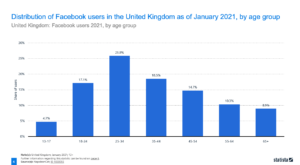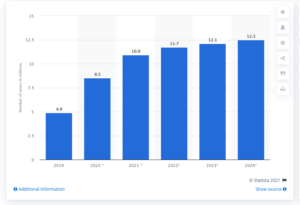Accessing The UK Opportunity in 2021
As the UK sees continued success with the vaccine roll-out and expects to emerge from the pandemic this year, now is the time for overseas brands to invest in their UK strategy. But what are the key considerations in achieving success in this established online market?
If there is one truth universally acknowledged from 2020, it’s that forecast posts tend to age badly. However, at the time of writing, the UK had hit its target of vaccinating the most vulnerable people by mid-Feb, having vaccinated over 15m people, so while the pandemic continues to be a major concern, there is some light at the end of the tunnel. The IMF reported in January 2021, that UK GDP is expected to grow 4.5% this year, and even further in 2022, out-indexing the average for advanced economies and the Eurozone. The Treasury’s forecasts compiled from independent economists, have this higher at 5.4% and the Bank of England are even more confident at 7.25%. Unfortunately, unemployment is expected to rise from 4.6% in 2020 to 7.4% in 2021, but again this is also two percentage points behind the Eurozone and better than many other advanced economies.
The past twelve months have been challenging for nearly everybody on some level, and many have suffered unexpected hardship alongside tragic personal loss. However for some “accidental savers”, the successive lockdowns have resulted in more disposable income in their pocket. There have been families who, while struggling with the realities of home-schooling their children, have saved on childcare, and commuters who have saved their commuting costs as they work from home. The restrictions on travel and socialising, while causing significant financial distress for many employed in the tourism and hospitality sectors, have resulted in others saving more than before. This led the Bank of England’s Andy Haldene to state that Britons have saved £125bn during the three lockdowns so far, and that this could increase to £250bn by the end of June.
As the UK emerges from the latest lockdown with the hope of the vaccine rollout, the government is now looking at how to incentivise private individuals to pump some of their savings back into the economy. This presents opportunities for brands to benefit from increased consumer spending.
The UK is forecast to be the fourth largest advertising market in 2021. It is also an advanced digital economy, with mature ecommerce operators and high expectations in terms of the customer journey. While marketers should always consult a detailed demographic breakdown and look to understand exactly how their products or services may be attractive to UK consumers, there are certain trends and nuances of the UK market that have broad implications.
Keeping it local#
Recent research found that 71% of British holidaymakers were intending to take a UK holiday in 2021, and while official advice is not to book anything yet, anecdotal reports are that holiday rentals are booking up fast. Foreign travel will not be allowed into 17th May at the earliest, and even when this is allowed, the majority of middle-aged people will still not be vaccinated, so overseas family summer holidays are likely to be minimal. Brands should however expect older people to be more likely to travel, as discussed below, and should prepare for a bounce-back of wider travel and hospitality consumption in the second half of 2021.
With another “Great British Summer” on the cards for many families, brands should expect to see an increase in demand for products and services suitable for spending time outside in the British climate. Expect crochet bikinis to be replaced by nautical stripes and waterproof layers. As more people continue to work from home, with many having moved to more rural locations, we can also expect to see an increase in sales of country attire and accessories and sports equipment. When it comes to producing content for these categories, particularly if localising from another language into English, it is really important to support your copy with thorough keyword research. English is rich in synonyms, so to really understand and capture demand, brands need to know their windcheaters from their cagoules, from their souwesters. It is also important to ensure British English is used throughout, to both ensure consumer engagement and also to avoid missed opportunities. Our article on “pants vs trousers” provides some additional insight on this.
For the love of dog#
The British are famously a country of animal lovers, with the Royal Society for the Prevention of Cruelty to Animals (RSPCA) being the first animal welfare charity established in 1824. The pandemic has seen many people with more free time, working from home and seeking companionship. As such there has been a spike in pet ownership, with particular growth in dog ownership. The UK pet food market is expected to reach £2.9bn in 2020, and pet accessories are also expected to remain resilient as the economy recovers.
Pets provide an opportunity for light relief when the pressures of the “new normal” become unsustainable. The recent Mars Petcare Comedy Photo Awards are a great example of combining a love of animals with a relaxed and humorous sensibility.


Unsurprisingly, with many people relying on their pets for company during the pandemic, the personification of pets continues to be a trend, so influencer marketing is an important strategy to boost brand engagement. For example some pets such as @errol.the.cat in the UK have more than 100k followers, with US influencers such as @juniperfoxx reaching upwards of 3m followers. The UK is a mature market for social media adoption, so achieving cut-through requires a deep understanding of the ad formats, but also the ability to tap into the British sense of humour and collective national mood. Yorkshire Tea has been extremely successful with posts such as the below, which tapped into anxiety around Christmas presents making it to their intended destination while hauliers were stuck getting Covid-19 tests before they could cross into France. The tone was humorous and light, but addressing a serious concern for many of their followers, thereby achieving excellent engagement.

Getting the tone of voice right for the UK market is incredibly important, so brands must create UK-specific style guides. Keyword research, tone-of-voice and branding considerations should come together in a single termbase. Using a termbase in the content production workflow will ensure both consistency and marketing performance is maintained, irrespective of the type of content or marketing channel. Locaria’s Locate platform combines content delivery best practice with digital marketing savvy.
The silver pound#
For digital marketers, the senior segment should be of increasing interest when targeting the UK. Not only is this segment relatively wealthy, but one result of the pandemic has been an increase in online engagement in those over 65. According to Saga, over-50s hold three quarters of the national wealth, and spend more heavily on services than products. Internet connections in households with one adult aged 65 years and over have increased by seven percentage points since 2019 to 80%. As the below chart shows, the over 50s now account for 25% of Facebook users in the UK, so brands looking to engage with this segment should consider the more established social media sites for both paid and organic activity.

Many baby boomers were already extremely capable in terms of online shopping and services, but lockdown has seen more of the later adopters move online. Those who were already au fait with online shopping for products may have also moved into online services. As the vaccine roll-out has focused on those more at-risk from the effects of Covid-19, the UK has already started vaccinating those in their early sixties, with older age groups already getting their second dose of the vaccine. This means that the older segment of society are likely to be more confident to travel, socialise and spend as the rules are relaxed.
A key consideration for ensuring engagement with your content by more senior consumers, and indeed those with any visual impairment, is accessibility. Not only should sites be mobile optimised to make the customer journey more easily readable, and colour contrast be considered, there are also issues with localisation. For your mobile site to work well, the content needs to fit, but also make the most of the space available. If you’re localising from Chinese to English, you will struggle to fit all the content from the Chinese site into the new site, as Chinese is a relatively “shorter” language. Conversely, German is much longer than English, so you may be left with a lot of space that could be better utilised to provide useful content. In both cases, building solutions for UK customers based on your current offering needs to consider content as well as functionality.
Community matters#
A positive outcome of the pandemic in the UK has been the widely reported increase in community sentiment. Initially small efforts have turned into huge phenomena, such as Captain Tom Moore’s sponsored walk of 100 laps of his garden, which eventually raised £32.7m. Lacking the ability to physically interact, these communally achieved results have been initially driven by the ability of social media to drive awareness. Captain Moore’s success was really due to him capturing the mood of the nation at a specific point and appealing to a very British sense of pride in the “keep calm and carry on” spirit of wartime Britain that he embodied. Brands seeking to grow engagement in the UK market must learn from this while also avoiding a cynical use of British cliches that will be easily recognised and could damage a brand’s reputation.
The lack of social interaction resulting from three national lockdowns has heavily impacted all segments, meaning social media has seen increased usage across the population, but nowhere is it more apparent than in tomorrow’s consumers i.e. young adults. TikTok user numbers in the UK are expected to grow to 12.5 million in 2024, with a particularly big leap into 2021, and more than a quarter of smartphone users on the platform being from the 18-24 age range.

Brands should be diverting out-of-home advertising spend into social media not only to take advantage of everybody being stuck at home, but also as a long-term strategy to build brand awareness and loyalty in the future.
Agencies can help brands ensure effective social media campaigns by providing culturally nuanced copywriting and storytelling, alongside an understanding of all the formats and buying options available. With our extensive network of creative copywriters and localisation experts who truly understand digital media, Locaria is available to help make the most of the UK opportunity in 2021.
Article written by Lindsay Hong



